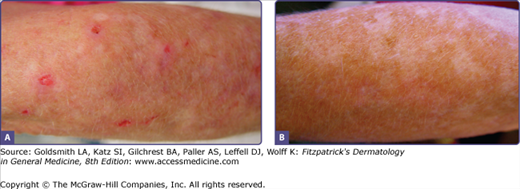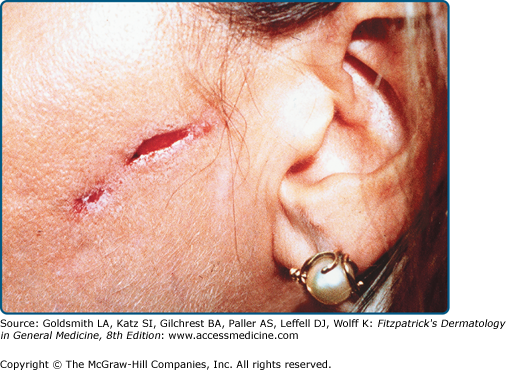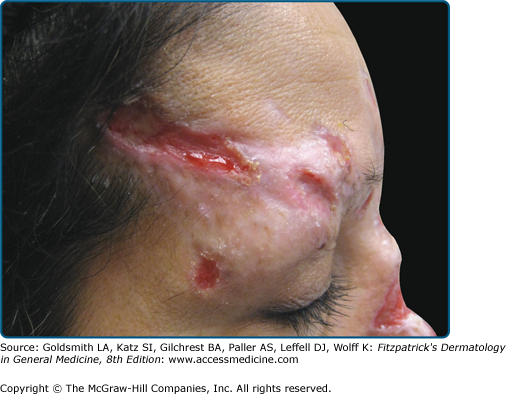Psychocutaneous Skin Disease: Introduction
|
Scientific advances are shedding new light on the understanding and treatment of long-recognized conditions located at the interface of dermatology and psychiatry. Both arising from ectoderm, the skin and the nervous system are connected by more than just their common origins. The skin is one of the major avenues by which humans perceive the world, and, in turn, are perceived by it. When these perceptions go awry, great distress may result. When the skin is markedly affected by a primary dermatologic condition, psychological sequelae in the form of comorbidity often follow, greatly impacting patient quality of life.
The central nervous system (CNS) can influence the health of other organ systems, including the skin. Psychophysiologic mechanisms for this interaction range from the stress responses mediated by neuroadrenal connections and associated changes in immunologic function, to the systemic and local action of various neuropeptides and neurohormones.1,2
Role of the Dermatologist
Between 20% and 40% of patients seeking treatment for skin complaints have some type of psychiatric or psychological problem causing or complicating the presenting symptoms.3,4 A large number of these patients lack insight into the possible psychogenic origin of their symptoms and are often reluctant to accept any kind of psychiatric referral. Therefore, in the absence of a psychiatry liaison clinic in the dermatologic setting,4 the dermatologist must be familiar with the most common of these diagnoses, their clinical manifestations (both psychological and dermatologic), and the basic principles of treatment. When approaching these issues, it is important to explore psychiatric, and particularly psychotic, symptoms as well as compliance with medications. Collateral informants such as family members can be quite helpful if the patient grants permission. Lastly, the effects of patient symptoms on familial and social life can be of much assistance in understanding the issues to be addressed.
Classification of Psychocutaneous Diseases
Following the original description of C. Koblenzer,5 psychocutaneous diseases can be classified on the basis of their primary etiology as:
- Primary psychogenic disorders, which can present with a variety of symptoms and behaviors, usually characterized by self-injury, that can lead to perceived or actual dermatologic conditions, or
- Primary dermatologic disorders that can be either triggered or amplified by contextual causes (e.g., life stresses or interpersonal relationships) that may lead to psychiatric comorbidities such as, anxiety, depression, and distress through their impact on physical appearance and well being. In some instances, the psychiatric comorbidities are not merely the result of the detrimental aspects of skin, but are associated to the pathophysiology of the dermatological disease itself. An example of the latter is the association of psoriasis with depression, in which both conditions share common inflammatory pathways.
The classification can guide in implementing an effective treatment approach including dermatologic, psychiatric, and contextual aspects of the disease aimed to interrupt the circular reinforcement of pathology. In this chapter, we focus on the description of the most frequent primary psychogenic disorders that present to the dermatologist, and require acknowledgement and treatment.
Primary Psychogenic Disorders
Frequently, these diseases are manifested by self-inflicted dermatosis. The most significant difference between them is the degree of insight or conscious perception of autoinjury. The classification of these disorders as delusional, factitial, somatoform, or compulsive is adapted for the clinical dermatological practice, following the one described in Clinical Management in Psychodermatology6 with the understanding that in many instances, disorders may span through various categories (Box 104-1), and may differ conceptually from the DSM-IV (Diagnostic and Statistical Manual of Mental Disorders, published by the American Psychiatric Association), which is directed towards the psychiatric practitioners7 and clinical studies.
Delusional | Delusion of parasitosis Body odor delusion Hypochondriacal syndrome Body dysmorphic disorders (BDDa)—somatic form |
Factitious | Dermatitis para-artefacta syndrome Dermatitis artefacta syndrome Malingering |
Somatoform | BDD Cutaneous dysesthesias Somatization syndrome |
Compulsive | Compulsive washing Lichen simplex chronicus BDD |
Delusional Disorders
Subjects with delusional disorders present with somatic complaints, no insight into the involved psychological issues, and encapsulated monosymptomatic delusions. Delusions are fixed, false beliefs that are not endorsed by the larger cultural, ethnic, or religious community. Patients’ unshakeable beliefs frequently coexist with a fairly intact character and personality structure. The most frequent form of this condition seen by dermatologists is delusion of parasitosis8 in which patients manifest the belief of being infested with parasites. Because this is frequently the only overt manifestation of the subject’s psychosis, these patients most often present to dermatologists and entomologists rather than to psychiatrists. Although we will describe below the more common form of delusions of parasitosis, there are other more rare forms of delusions such as hypochondriacal, where patients believes that they are afflicted by a particular disease (such as AIDS, cancer, etc.), or delusions of body odor. In many instances, patients with body dysmorphic disorder (BDD) may have the unshakeable delusional conviction that they have a severe physical disfigurement.
This disease predominates in middle aged to elderly females with premorbid social isolation. In approximately 12% of patients, the delusion of infestation is shared or at least endorsed by a family member (folie a deux).9,10
Patients with delusional parasitosis frequently present to the clinician in an anxious, ruminative, overwhelmed state, with a history of visits to multiple physicians without satisfaction. In addition to proffering a long and detailed history that includes visual or tactile hallucinations of the organisms, the patient also frequently provides “evidence” of the parasitic infection in the form of clothing lint, skin crusts, or other debris, the so-called “matchbox sign”11 (these items are collected in a matchbox to be presented to the physicians), which is delusionally misinterpreted as entire organisms, body parts, larvae, or ova. Skin manifestations can be quite variable, if present. Lesions ranging from mild excoriations (Fig. 104-1A) to large ulcers may reflect patients’ unsuccessful attempts at treating the perceived infestation.12 Because this is a monosymptomatic delusional disorder, some patients have a well-organized train of thought and normal outward appearance and behavior, resulting in the conviction by those surrounding them that the subject has a true infestation. The delusion becomes apparent to the physician when the subject is approached.
Actual infestation and underlying skin or systemic disorders must be ruled out (see Box 104-2). Subsequently, the differential diagnosis of psychosis must be considered, distinguishing between the primary psychiatric conditions that manifest with delusions of infestation. True monosymptomatic hypochondriasis represents a form of delusional disorder characterized by a discrete, circumscribed delusional belief with possible associated hallucinations without clear syndromic changes in affect or personality.7 On the contrary, patients with uni- or bipolar depressive psychosis will describe predominantly classic changes in mood, motivations, sleep, and appetite. Schizophrenic patients may have a history of previous psychotic episodes and often show deterioration in global functioning, impaired social relatedness, thought disorder, paranoid traits, and more bizarre and extensive delusions and hallucinations. In arriving at the diagnosis, it is critical that the clinician differentiate true delusions of parasitosis from formication, which involves the cutaneous sensation of crawling, biting and stinging, but lacks the fixed unshakeable conception that the skin sensations are induced by parasites.
DERMATOLOGIC | SYSTEMIC | PSYCHIATRIC |
|---|---|---|
Chronic folliculitis | Dementia | Cocaine use |
Insect bite reactions | Malignancy (brain) | Amphetamine use |
Dermatitis artefacta | Cerebrovascular disease | Psychotic-spectrum illness |
Dermatitis para-artefacta | Vitamin B12 deficiency | Affective disorders |
Although often regarded as chronic, unremitting, and difficult to treat, these patients have an improved recovery rate following appropriate pharmacologic therapy.
The critical tenet of treatment is to keep the patient engaged. Empathetic listening, statements of concern, and examinations of the material that patients brings in help to establish rapport. Because these patients will frequently reject psychiatric referrals,13 various authors have suggested means of increasing trust, thus paving the road towards psychiatric evaluation.13,14 It is critical that the dermatologist avoids confronting the patient directly, and exhibits interest in the chief complaint patiently. After a few visits, the physician may carefully introduce the notion that the parasites may not be present, or that the patient is so distressed by this condition, that the prescription of psychotropic medication could be warranted. Targeted therapy is undertaken with antipsychotic medications (Fig. 104-1B).15 Pimozide has been used historically as the drug of choice,16,17 although it is now being replaced by atypical antipsychotics, which are associated with a more favorable side effect profile (eBox 104-2.1).14,18 The clinician needs to be aware of the need for monitoring for metabolic syndrome characterized by abdominal obesity, insulin resistance and impaired glucose tolerance, disturbance in lipid metabolism, hypertension, and weight gain. In many instances, the psychotropic medication needs to be introduced by the dermatologist, and only when the patient begins to respond favorably is it possible to obtain a referral to a psychiatrist.
SIDE EFFECTS | |||||||
|---|---|---|---|---|---|---|---|
DRUG | DOSE (mg/day) | EPS | NMS | Metabolic Syndrome | Seizure (at High Doses) | Cardiac | Othera |
Clozapine: Clozaril™c | 25–900 | +/−d | +/− | ++++ | + | Myocarditis, hypotension | Agranulocytosise |
Olanzapine: Zyprexa™ c | 2.5–15 | +/−d | +/− | ++++ | + | Hypotension | Dizziness |
Risperidone: Risperdal™ c | 0.25–8 | +/−d | +/− | +++ | + | Hypotension | Hyperprolactinemia, dizziness |
Paliperidone: Invega™ c | 1.5–12 | +/−d | +/− | +++ | + | Arrhythmia, prolonged QT, hypotension | Hyperprolactinemia, tachycardia |
Quetiapine: Seroquel™ c | 25–800 | +/−d | +/− | +++ | + | Hypotension | Cataracts |
Ziprasidone: Geodon™ c | 20–160 | +/−d | +/− | ++ | + | Arrhythmia, prolonged QT, hypotension | |
Aripiprazole: Abilify™ c | 2–30 | +/−d | +/− | ++ | + | Hypotension | Headache |
Pimozide: Orap™ (typical antipsychotic) | 1–10 | +++ | +++ | – | ++ | Arrhythmia, prolonged QT, hypotension | |
Factitious Disorders
This group of syndromes is characterized by self-inflicted dermatological disease; they are mostly differentiated based on the degree of insight or consciousness of their behavior.
Dermatitis artefacta is a form of factitious disorder in which patients intentionally feign symptoms and produce signs of disease in an attempt to assume the patient role.6 Unlike patients with malingering who engage in similar behavior for external or “secondary gain” (such as monetary reward or relief from occupational or other social responsibilities), the factitious patient seeks the “primary gain” of the emotional and psychological benefits that accrue to those who are “ill.” Patients with borderline personality disorder also frequently exhibit self-mutilatory behavior19 as do patients who consume cocaine or methamphetamine. However, their reasons for self-mutilation are variable, and are not usually consistent with efforts for primary or secondary gain. Occasionally, a psychologically disturbed adult will induce skin lesions in their children.20
Predominating in females, the age of onset varies significantly from adolescence through adulthood.21 Comorbid depressive and personality disorders may also be seen coexisting with this rare syndrome.6
Although it has long been observed that patients with dermatitis artefacta may present with lesions in virtually all areas of the body that can mimic most dermatoses, some common elements may hint at this diagnosis. Lesions are often in areas readily accessible to the patient, and may have geometric patterns or angulated borders surrounded by completely healthy skin. Morphology is often bizarre and does not conform to typical presentations of known dermatoses (Figs. 104-2 and 104-3). Patients are often unable to provide a clear history of the initial appearance or evolution of the process, typically deny any role in the production of the lesions, and may self-induce the lesions in a dissociated state.22 Characteristically, the histopathology is unrevealing.
As in all cases of factitious disease, the clinician must rule out possible disease entities that are consistent with the history and clinical findings. Unusual presentations of common illnesses and rare conditions must be entertained. However, exhaustive searches for primary skin pathology without supporting clinical evidence may compound the problem and actually perpetuate the patient’s factitious behavior. Occlusive dressings (e.g., an Unna boot) or other means of preventing manipulation by the patient lead to healing of the lesions and are often helpful strategies in clarifying the diagnosis.
A supportive, nonconfrontational, empathic approach to the patient is indicated initially. Immediate confrontation regarding the suspicion that the patient’s lesions are self-induced can be counterproductive in that the patient often flees from treatment. Frequent visits and symptomatic topical treatments are initially useful.23 However, the clinician must be careful not to collude in the patient’s abnormal illness behavior. Ultimately, the recognition of the patient’s role in the production of the lesions must be broached. The goal is to establish a trusting relationship such that the patient will accept a psychiatric referral. Antidepressants (eBox 104-2.2) and low-dose atypical antipsychotics (eBox 104-2.1) have been reported to be useful adjunctive therapies.24,25 In the case of inflicted lesions in a child protective services or equivalent agencies must be alerted immediately to safeguard the welfare of the child.
MECHANISM OF ACTION/CHEMICAL STRUCTURE | DRUG | DOSEb (mg/day) | SIDE EFFECTS |
|---|---|---|---|
Selective serotonin reuptake inhibitors (SSRIs) | Citalopram: Celexa™ Escitalopram: Lexapro™ Fluoxetine: Prozac™ Fluvoxamine: Luvox™ Paroxetine: Paxil™ Sertraline: Zoloft™ | 10–40 10–20 20–80 100–300 10–60 50–200 | Anxiety, irritability, increased suicide rates, akathisia, sexual dysfunction, hypomania/mania, agitation, weight gain. |
Serotonin-norepinephrine reuptake inhibitors (SNRIs) | Venlafaxine: Effexor™ Desvenlafaxine: Pristiq™ Duloxetine: Cymbalta™ Milnacipran: Savella™ c | 37.5–375 50 30–120 25–200 | Hypertension, tachycardia, dizziness, anxiety, nausea, sexual dysfunction, sleep disturbance |
Norepinephrine-dopamine reuptake inhibitors (NDRIs) | Bupropion: Wellbutrin™ | 100–450 | Seizures. Avoid in patients with convulsive history, eating disorders or alcohol withdrawal. |
Blockage of presynaptic reuptake of monoamines: Tricyclics (TCAs) | Amitriptiline: Elavil™ | 25–150 | Arrythmias, hypertension, orthostatic hypotension, dry mouth, constipation, sexual dysfunction, sedation; avoid in glaucoma |
Nortriptyline: Aventyl™ | 25–150 | ||
| Pamelor ™ | 150–250 | ||
Clomipramine: Anafranil™ | 25–300 | ||
Doxepine: Sinequan™ | |||
Presynaptic α2, 5HT2c/5HT3 antagonist | Mirtazipine: Remeron™ | 15–45 | Agranulocytosis, weight gain, dizziness, sedation. |
These are fundamentally determined by the underlying psychopathology. In those patients with severely disturbed personalities, the recurrent self-defeating and destructive behaviors are likely to continue.
These are a group of factitious diseases, where problems of impulse control play a significant role; the patients are conscious or semiconscious of manipulating their skin, but are unable to stop this behavior.
Trichotillomania is an impulse control disorder,7 characterized by repetitive pulling of hair, resulting in alopecia. Strict criteria also include a build up of tension before hair pulling or when resisting an urge to do so, pleasure or relief after pulling out the hair, and significant functional impairment and distress in the patient.
Prevalence rates are estimated to be between 0.5% and 3.5% with a mean age of onset between 10 and 13 years. Despite its current classification, there are marked similarities with obsessive-compulsive disorder (OCD), which may have important treatment implications.26–28 Comorbid psychiatric disorders are depression, anxiety, and OCD.
Stay updated, free articles. Join our Telegram channel

Full access? Get Clinical Tree










